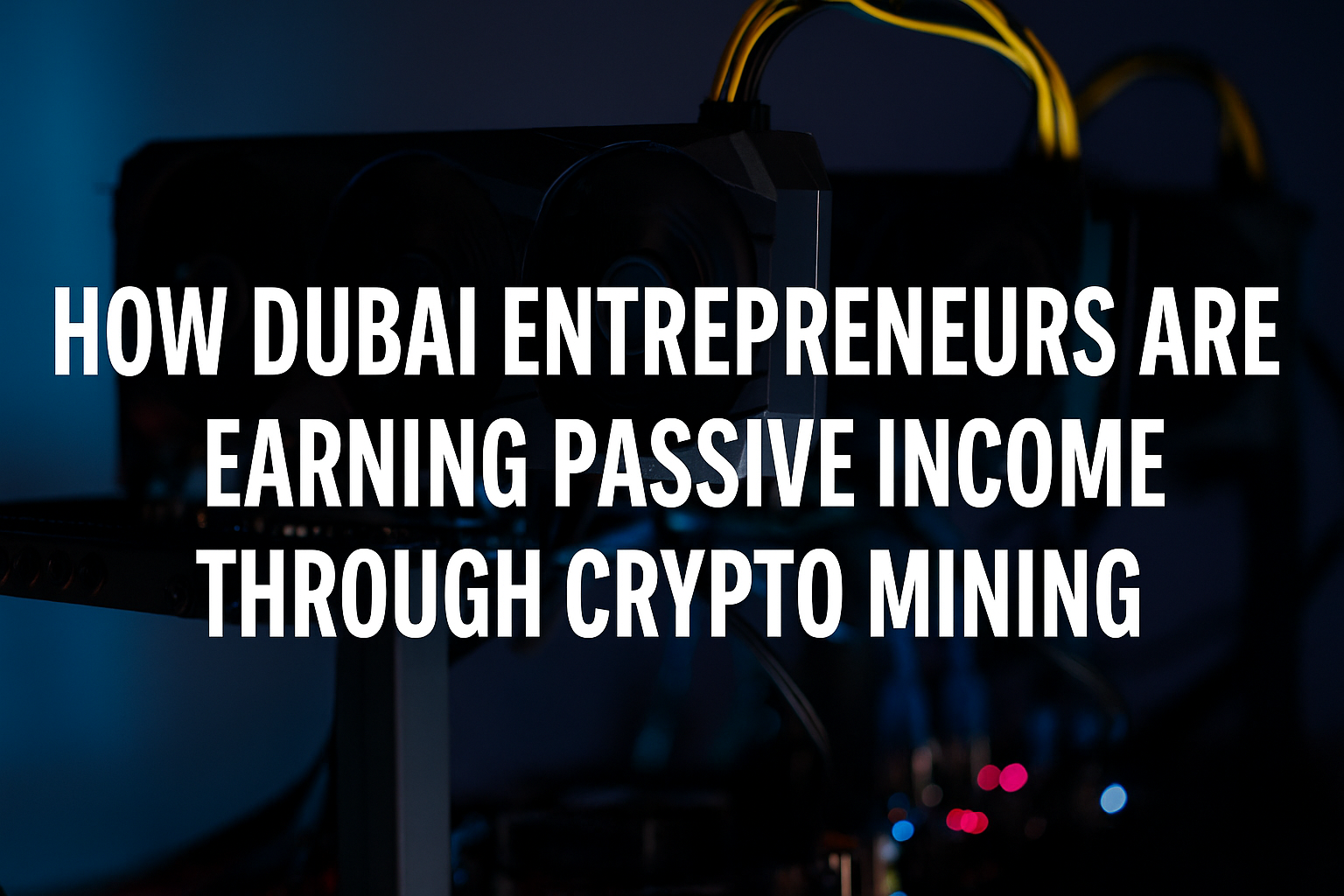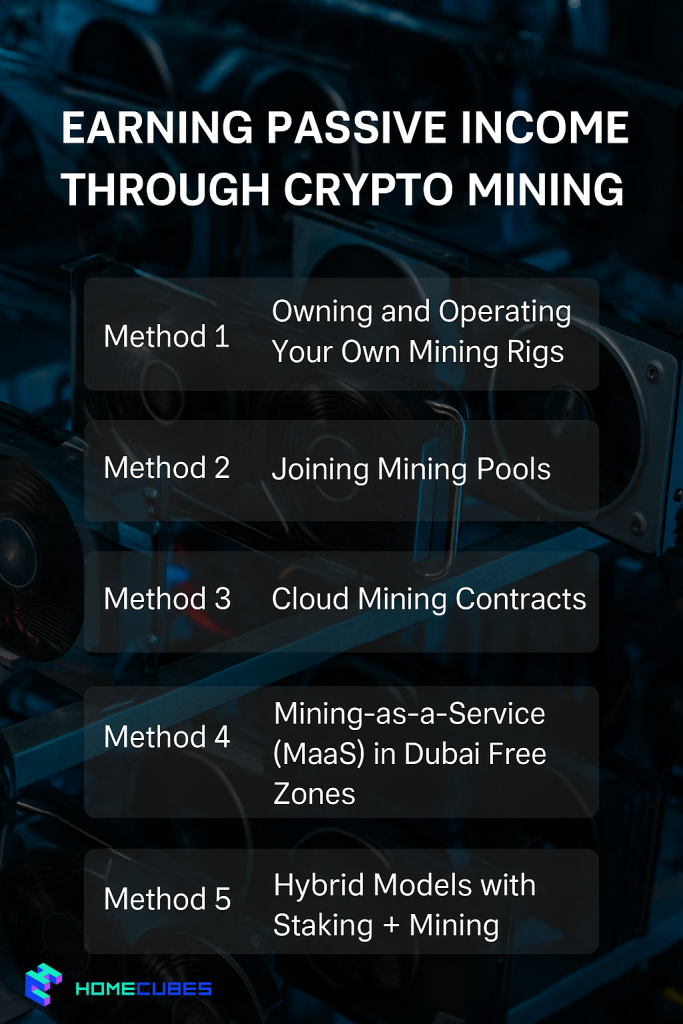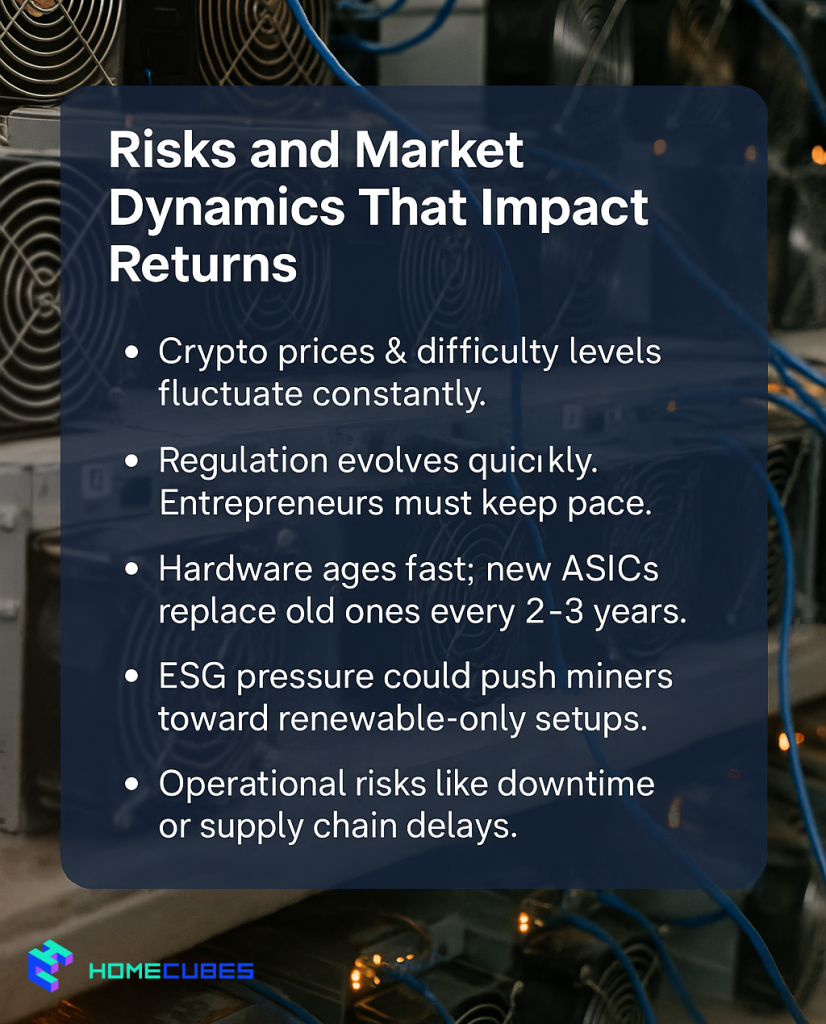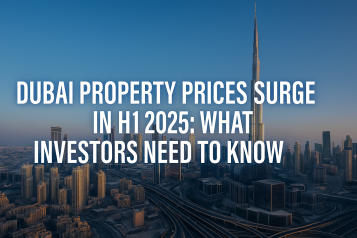

Table of Contents
- Introduction: Why Passive Income from Crypto Mining Appeals to Dubai Investors
- What Passive Income Really Means in Crypto Mining
- Method 1: Owning and Operating Your Own Mining Rigs
- Method 2: Joining Mining Pools
- Method 3: Cloud Mining Contracts
- Method 4: Mining-as-a-Service (MaaS) in Dubai Free Zones
- Method 5: Hybrid Models with Staking + Mining
- Case Study: Comparing Earnings Across Mining Methods
- Mistakes to Avoid in Passive Income Mining
- Costs, Fees, and Licensing Requirements in Dubai
- Risks and Market Dynamics That Impact Returns
- Outlook 2025–2030: The Evolution of Passive Income Mining
- Frequently Asked Questions (FAQs)
- Final Thoughts
- Unlock Passive Income Potential with Homecubes
Introduction: Why Passive Income from Crypto Mining Appeals to Dubai Investors
Dubai has emerged as one of the most attractive global hubs for blockchain adoption and crypto-based entrepreneurship. With a combination of strategic location, business-friendly taxation, government support and crypto becoming the preferred method of payment in the UAE, it has become a natural magnet for miners and Web3 founders. Unlike jurisdictions that ban or restrict mining, Dubai provides regulatory clarity and infrastructure stability, making it possible to design long-term mining strategies.
For entrepreneurs, crypto mining represents an opportunity to build predictable recurring income through DeFi platforms for earning passive income in the UAE, while also participating in a transformative financial technology wave. Instead of chasing speculative trades, mining provides ongoing asset inflows that can be managed, reinvested, or diversified into other tokenized opportunities.
🇦🇪 UAE IS MINING #BITCOIN WITH GOVERNMENT RESOURCES 👀 pic.twitter.com/Y0BNxHxlkz
— Bitcoin MENA Conference (@bitcoinmenaconf) October 30, 2024
This article explores the practical methods of generating passive income through crypto mining in Dubai, highlighting what makes each approach attractive, how to manage risks, and what to expect in terms of costs and returns.
What Passive Income Really Means in Crypto Mining
The idea of “passive income” can sometimes be misleading. While crypto mining generates continuous rewards, the level of involvement required varies depending on the chosen strategy.
For example, running your own mining rigs means buying hardware, setting up infrastructure, and dealing with cooling and maintenance. It produces income but requires effort. On the other hand, cloud mining contracts or outsourced MaaS hosting allow entrepreneurs to receive crypto payouts without ever touching the hardware.
In Dubai’s context, passivity is also tied to compliance and energy efficiency. The less time spent navigating regulatory uncertainty and infrastructure headaches, the more “passive” the income feels.
Method 1: Owning and Operating Your Own Mining Rigs
How it works: Investors purchase ASICs or GPUs, install them in cooled facilities, and connect them to networks like Bitcoin or Litecoin. They earn rewards directly in crypto.
Why it’s attractive:
- 100% of the rewards stay with the operator.
- Hardware retains resale value.
- Complete control over energy sourcing and setup.
Challenges in Dubai:
- Cooling expenses are higher due to the desert climate.
- Professional licensing is mandatory for large operations.
- Requires strong technical know-how.
ROI Example: With modern ASICs and Dubai’s energy pricing (DEWA Slab Tariff), break-even often lands around 16–20 months, depending on Bitcoin difficulty cycles.
Expansion insight: For entrepreneurs who already operate small businesses (e.g., in IT or facilities management), owning rigs can be a natural extension. Leveraging existing warehouse space or negotiating bulk energy rates can significantly improve returns.
Method 2: Joining Mining Pools
How it works: Multiple miners contribute computing power into a pool. The pool then distributes rewards proportionally.
Pros:
- Smooths out inconsistent block rewards.
- Easier entry for small-scale miners.
- Pools often handle software and network connectivity.
Cons:
- Fees of 1–3% reduce income.
- Large pools create concentration risks.
Expansion insight: In Dubai, mining pools can be paired with family-office style investments, where groups of investors contribute hardware together. This reduces individual risk and creates a cooperative model that suits smaller entrepreneurs.

Method 3: Cloud Mining Contracts
How it works: Rent hash power through a subscription. Providers deliver payouts according to contract terms.
Pros:
- No hardware management.
- Low entry point for beginners.
Cons:
- History of scams and rug pulls in the sector.
- Fees eat into returns.
Entrepreneurs should work only with providers aligned with VARA’s Rulebooks.
Expansion insight: Cloud mining can also serve as a hedge strategy. For example, an investor who already operates rigs can allocate a smaller budget to cloud contracts, ensuring continuity if on-site operations face downtime.
Method 4: Mining-as-a-Service (MaaS) in Dubai Free Zones
How it works: Investors buy rigs but colocate them with a professional MaaS operator inside licensed facilities (e.g., DMCC).
Pros:
- Hands-off while maintaining ownership.
- Licensed operators ensure compliance.
- Professional-grade uptime and cooling.
Cons:
- Hosting fees reduce overall yield.
- Long-term contracts may limit flexibility.
Expansion insight: MaaS is attractive to entrepreneurs who want to focus on scaling their core business while still enjoying mining returns. It essentially turns mining into a “plug-and-play” income stream backed by professional SLAs.
Method 5: Hybrid Models with Staking + Mining
How it works: Allocate capital between Proof-of-Work mining (e.g., BTC) and Proof-of-Stake staking (e.g., ETH, ADA).
Pros:
- Diversification across income types.
- Staking helps stabilize cashflow.
- Lower risk of overexposure to mining cycles.
Cons:
- More complexity to manage.
- Different compliance regimes may apply.
Expansion insight: Many Dubai entrepreneurs use hybrid models to smooth returns. For example, mining Bitcoin while staking ETH on regulated exchanges can balance volatility with steady staking yields.
Case Study: Comparing Earnings Across Mining Methods
Scenario: USD 50,000 allocated across mining approaches.
- Self-Owned Rigs (10 ASICs): ~USD 1,800 net/month; ROI ~18 months.
- Mining Pool (5 ASICs): ~USD 600 net/month; ROI ~24 months.
- Cloud Mining (USD 10k contract): ~USD 350 net/month; ROI ~28 months.
- MaaS Hosting (USD 40k): ~USD 2,200 net/month; ROI ~16–18 months.
- Hybrid (25k rigs + 25k staking): ~USD 1,900–2,100 net/month; ROI ~18–22 months.
Volatility note: If BTC drops 20%, ROI periods stretch significantly; if BTC rallies 30%, MaaS and rigs outperform. Passive income is always linked to market cycles.
Mistakes to Avoid in Passive Income Mining
- Overestimating profitability during bull runs.
- Ignoring cooling needs in Dubai’s climate.
- Failing to check cloud provider legitimacy.
- Overcommitting without licensing.
- Not diversifying across methods.
Costs, Fees, and Licensing Requirements in Dubai
- Licensing: DIFC uses its own framework (see DFSA Innovation & Crypto).
- Legal clarity: DIFC Digital Assets Law (No. 2 of 2024) defines enforceability.
- Energy: Tariffs by DEWA determine profitability.
- Hosting: MaaS fees run 20–30%.
- Insurance: Important for protecting high-value rigs.
Risks and Market Dynamics That Impact Returns

- Crypto prices & difficulty levels fluctuate constantly.
- Regulation evolves quickly. Entrepreneurs must keep pace.
- Hardware ages fast; new ASICs replace old ones every 2–3 years.
- ESG pressure could push miners toward renewable-only setups.
- Operational risks like downtime or supply chain delays.
Expansion insight: Dubai is actively positioning itself as a green technology hub, so future mining opportunities may link with renewable energy credits or carbon offset markets.
Outlook 2025–2030: The Evolution of Passive Income Mining
- Energy diversification: Guided by the UAE Energy Strategy 2050.
- MaaS specialization: Expect modular immersion cooling, dedicated free zone clusters, and audited facilities.
- Hybrid adoption: More entrepreneurs will balance PoW mining with staking.
- Institutional entry: Expect banks and funds to demand custody solutions and audited revenue streams.
- Integration with tokenized real estate: Mining income could be pooled or collateralized alongside fractional property tokens.
Frequently Asked Questions (FAQs)
1) Is crypto mining legal in Dubai, and who regulates it?
Yes. Crypto mining is permitted in Dubai if conducted under the proper framework and license. Outside the DIFC, activities are overseen by Dubai’s Virtual Assets Regulatory Authority (VARA).
2) How profitable is passive income from crypto mining in Dubai?
Profitability depends on hardware, power, and market conditions. A small ASIC setup can make ~USD 1,500+ monthly, while MaaS-hosted operations scale higher.
3) What is the easiest way for a beginner to start crypto mining in Dubai?
The simplest entry points are cloud mining contracts and MaaS hosting. Both avoid technical setup, letting beginners focus on capital deployment and payout tracking.
4) How much capital do I need to start crypto mining in Dubai?
- Cloud mining: USD 1,000–2,000 minimum.
- Small home/office rigs: USD 10,000–15,000+.
- MaaS hosting: USD 20,000–40,000+.
5) Which method of crypto mining is the most passive for Dubai investors?
Cloud mining is fully hands-off but less profitable. MaaS hosting is considered the most practical passive option because you own the rigs while outsourcing management and compliance.
6) How do electricity and cooling costs affect mining profitability in Dubai?
Energy and cooling are the largest expenses. Efficient ASICs and professional facilities are critical in Dubai’s climate. Even small gains in energy efficiency and uptime can dramatically improve ROI.
7) Do I need a commercial license to run crypto mining rigs in Dubai?
Yes, for professional or large-scale operations. While small home setups may be tolerated, commercial activities require licensing through VARA or DIFC, depending on location.
8) What are the biggest risks to passive income crypto mining in Dubai?
Price volatility, rising network difficulty, outdated hardware, and unreliable providers are the main risks. Mitigation strategies include diversification, insurance, and working with licensed operators.
Final Thoughts
Passive income crypto mining Dubai is a viable but nuanced path. Each method — from self-owned rigs to MaaS — has its own balance of risk, effort, and return.
For Dubai entrepreneurs, the biggest advantage lies in combining mining with the emirate’s broader Web3 ecosystem: tokenized real estate, digital identity, and regulatory clarity. Together, they create a sustainable framework for long-term wealth creation.
Unlock Passive Income Potential with Homecubes
At Homecubes, we aim to make digital wealth strategies transparent and compliant. Our focus spans real estate tokenization, Web3 income models, and blockchain innovation.
Our VARA license application is under review. Once approved, we’ll launch solutions that help investors tap Dubai’s passive income opportunities safely and efficiently.
👉 Contact Homecubes to join our waitlist and explore opportunities.










